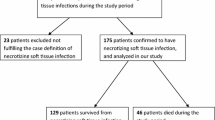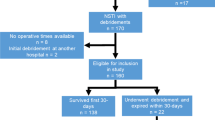Abstract
Background
Frequently, surgical intervention is needed to treat soft tissue sepsis (STS). Ideally, most STS should be managed at the lowest level of surgical care close to the patient’s home and a well-functioning surgical service will be able to deliver this safely and effectively. This study interrogates the burden of STS in the province of KwaZulu-Natal and reviews at which level in the health system the operative management of STS is being dealt with.
Methods
This study describes the operations for soft tissue sepsis conducted at all regional and tertiary hospitals in KwaZulu-Natal province for the period of 1 July to 31 December 2015. All procedures for soft tissue sepsis were identified for closer review.
Results
Between 1 June and 31 December 2015, a total 6302 soft tissue-related procedures were performed in the regional and tertiary hospitals of KZN. The breakdown by anatomical region was as follows, 618 (9.8%) head and neck surgeries, 895 (14.2%) chest and back, 277 (4.4%) abdominal wall, 818 (13%) pelvis/perineal/buttock and 3070 (48.7%) extremity-related surgeries. There were a further 815 (12.9%) soft tissue-related procedures where the anatomical region was unspecified. Of the soft tissue procedures, 3943 (62.6%) were for the management of soft tissue sepsis. The anatomical regions involved included 316 (8%) head and neck, 485 (12.3%) chest and back, 194 (4.9%) abdominal wall, 589 (14.9%) pelvic, perineal and buttock, 2054 (52.1%) extremity and 365 unspecified operations. Peri-anal sepsis contributed 315 (8%), breast sepsis contributed to 372 (9.4%) of all soft tissue sepsis and amputations of extremities 658 (16.7%) of septic soft tissue procedures.
Conclusion
There is a significant burden of soft tissue sepsis requiring surgical treatment each month at regional and tertiary hospitals in KZN. This is made up of breast sepsis, peri-anal sepsis and diabetic foot sepsis. This burden is being managed at an inappropriate level of care.



Similar content being viewed by others
References
Meara JG, Leather AJ, Hagander L et al (2015) Global surgery 2030: evidence and solutions for achieving health, welfare, and economic development. Lancet 386:569–624
World Health Organisation (2003) Surgical care at the district hospital. WHO, Geneva. https://www.who.int/surgery/publications/scdh_manual/en/. Accessed May 2020
Declaration of Alma-Ata: International Conference on Primary Health Care, Alma-Ata, USSR (1978) https://www.who.int/publications/almaata_declaration_en.pdf. Accessed 06 June 2019
Rayne S, Burger S, Straten SV, Biccard B, Phaahla MJ, Smith M (2017) Setting the research and implementation agenda for equitable access to surgical care in South Africa. BMJ Glob Health. 2(2):e00017. https://doi.org/10.1136/bmjgh-2016-000170
Luboga S, Macfarlane SB, von Schreeb J et al (2009) Increasing access to surgical services in sub-Saharan Africa: priorities for national and international agencies recommended by the Bellagio Essential Surgery Group. PLoS Med 6:e1000200
Groen RS, Samai M, Stewart KA et al (2012) Untreated surgical conditions in Sierra Leone: a cluster randomised, cross-sectional, countrywide survey. Lancet 380:1082–1087
Mock C (2013) Confronting the global burden of surgical disease. World J Surg 37:1457–1459. https://doi.org/10.1007/s00268-013-2102-x
Stewart B, Khanduri P, McCord C et al (2014) Global disease burden of conditions requiring emergency surgery. Br J Surg 101:e9–e22
Sharma D, Hayman K, Stewart BT et al (2015) Surgery for conditions of infectious etiology in resource-limited countries affected by crisis: the Médecins Sans Frontières Operations Centre Brussels experience. Surg Infect (Larchmt) 16(6):721–727. https://doi.org/10.1089/sur.2015.012
Hernandez MC, Finnesgaard E, Aho JM, Kong VY, Bruce JL, Polites SF, Laing GL, Clarke DL, Zielinski MD (2017) Appendicitis: rural patient status is associated with increased duration of prehospital symptoms and worse outcomes in high-and low-middle-income countries. World J Surg. https://doi.org/10.1007/s00268-017-4344-5
Kong VY, van der Linde S, Handley J, Aldous C, Clarke DL (2013) Quantifying the disparity in outcome between urban and rural patients with acute appendicitis in South Africa. S Afr Med J 103(10):742–745. https://doi.org/10.7196/samj.7109.:1.71
Tefera A, Lutge E, Sartorius B, Clarke D (2019) The operative output of district hospitals in KwaZulu-Natal Province is heavily skewed toward obstetrical care. World J Surg 43(7):1653–1660. https://doi.org/10.1007/s00268-019-04985-1
Laing GL, Skinner DL, Bruce JL, Aldous C, Govindasamy V, Thomson SR, Clarke DL (2017) Auditing surgical service provision at a South African tertiary institution: implications for the development of district services. S Afr J Surg 55(4):31–35
Prin M, Guglielminotti J, Mtalimanja O, Li G, Charles A (2018) Emergency-to-elective surgery ratio: a global indicator of access to surgical care. World J Surg 42(7):1971–1980. https://doi.org/10.1007/s00268-017-4415-7
Obermeyer Z, Abujaber S, Makar M, Stoll S, Kayden SR, Wallis LA, Reynolds TA, Acute Care Development Consortium (2015) Emergency care in 59 low- and middle-income countries: a systematic review. Bull World Health Organ 93(8):577–586. https://doi.org/10.2471/BLT.14.148338
Khan MZ, Smith MT, Bruce JL, Kong VY, Clarke DL (2020) Evolving indications for lower limb amputations in South Africa offer opportunities for health system improvement. World J Surg. https://doi.org/10.1007/s00268-019-05361-9
Funding
No external or internal funding was utilized to generate this work.
Author information
Authors and Affiliations
Corresponding author
Ethics declarations
Conflicts of interest
The authors have no conflicts of interest to declare.
Additional information
Publisher's Note
Springer Nature remains neutral with regard to jurisdictional claims in published maps and institutional affiliations.
Rights and permissions
About this article
Cite this article
Ehlers, V., Kohler, C., Di Rago, N. et al. Soft Tissue Sepsis Places a Massive Burden on Regional and Tertiary Surgical Services in KZN Province South Africa. World J Surg 44, 2526–2532 (2020). https://doi.org/10.1007/s00268-020-05510-5
Published:
Issue Date:
DOI: https://doi.org/10.1007/s00268-020-05510-5




